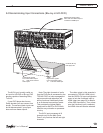
User's Manual
14
CHAPTER 1
Observe the following precautions
when choosing a location for your
TGR-401:
Make sure the TGR-401 has
good ventilation. Do not cover
any of the ventilation slots, or
t the receiver inside a sealed
cabinet without good air ow.
• Protect it from prolonged exposure
to direct sunlight and other direct
sources of heat, such as heating
vents and radiators.
• Do not expose the unit to rain or
moisture. If uid or a foreign object
should enter the unit, immediately
turn off the power and contact your
Sunre Dealer.
• Avoid excessive exposure to ex-
treme cold or dust.
• Do not place heavy objects on top
of the unit.
AC Power Considerations
Ensure that the unit is plugged into
an outlet capable of supplying the cor-
rect voltage specied for your model.
Care
If you need to clean the front sur-
face, rst turn off the power and then
use a soft dry cloth, rubbing with the
grain. Be careful not to scratch the
display window.
Connection Tips
Before setting up your new system,
please consider the following :
Always make sure that your
components are all turned
OFF, or unplugged before
making or changing any
connections.
• Whenever possible, route the
power cords away from the signal
cables or speaker wires to prevent
any hum or interference heard in
the speakers.
• Choose reliable hookup cables.
They should be fully shielded and
as short as possible.
• Use quality coaxial digital cables
to connect the TGR-401 to any
source equipment which has co-
axial digital outputs.
• Some patch cords can be a very
tight t and there is usually a
preferred method of getting them
off. Some have to be removed
with a twisting action. Be gentle or
you may damage the jacks of your
TGR-401, or other components.
• Some audiophile cables should be
hooked up in one direction, these
are usually marked with arrows.
• It is usual for the right channel
patch cord plugs to be red and
the left channel connections to be
white, grey or black. Composite
video connections are usually yel-
low.
Installation
Video Connections
The TGR-401 has four types of
video connections: composite video,
S-video, component video and HDMI.
Choose component or S-video if your
video system supports it, as this will
give better picture quality than com-
posite video.
When an audio/video component
is selected, the audio will play in your
system and the video will be switched
to a video input of your TV monitor.
You must have the TV connected
in order to see the On Screen Display
(OSD). No OSD is available on HDMI.


















